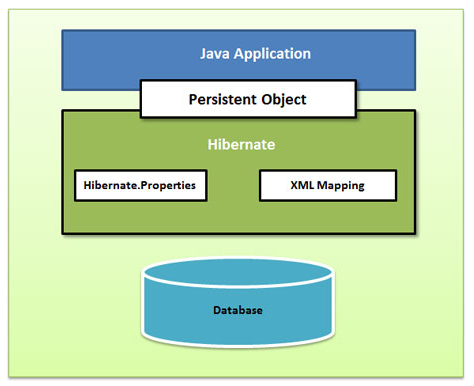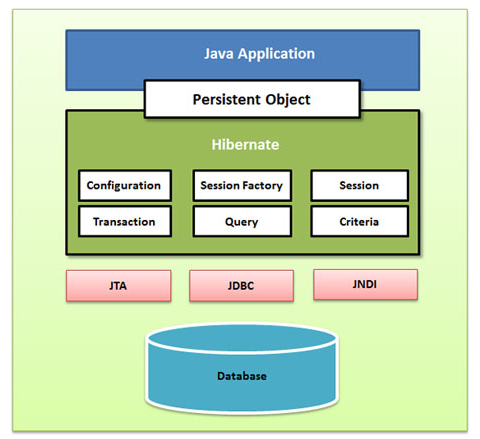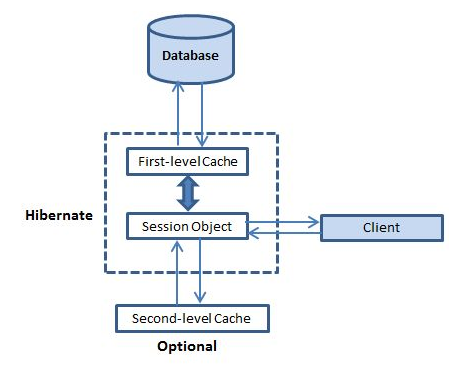- Hibernate
Hibernate
ORM
Object Relational Mapping
converting data between relational databases and object oriented programming languages such as Java

Advantages
- takes care of mapping Java classes to database tables using XML files and without writing any line of code
- Provides simple APIs for storing and retrieving Java objects directly to and from the database.
- Minimize database access with smart fetching strategies.
总结:千言万语汇成一句,就是用起来方便。对于数据库的读写,Dev不需要写那么多SQL,而是直接进行Object操作就可以。
Architecture
宏观上看,Hibernate连接了Java Applicaiton和DB。更细节地说,这种linkage通过以下两个方面实现:
- Hibernate.Properties(
hibernate.cfg.xml) -> link hibernate to database - XML Mapping(
Entity.xmlor usingAnnotation) -> link object to table

更加深入地看:
- Hibernate和DB之间其实还是通过JDBC等连接起来的
- Hibernate自身也可以分为多个模块:Configuration,Session,Query,Txn等等,这些都是我们编程的时候会接触到的

Steps to use Hibernate
- pre
- (把需要map的两个东西准备好)
- create persisted classes
- create database tables
- core
- dependency: jar / import
- link Hibernate to DB: create
hibernate.cfg.xml - do mapping: create xml / annotation
- start query: create transaction class
Persistent Class
需要persist的类
Java classes whose objects or instances will be stored in database tables are called persistent classes in Hibernate.
- All Java classes that will be persisted need a default constructor.
- All classes should contain an ID in order to allow easy identification of your objects within Hibernate and the database. This property maps to the primary key column of a database table.
- All attributes that will be persisted should be declared private and have getXXX and setXXX methods defined in the JavaBean style.
e.g. Employee.java
public class Employee {
private int id;
private String firstName;
public Employee() {}
public Employee(String fname) {
this.firstName = fname;
}
public int getId() {
return id;
}
public void setId( int id ) {
this.id = id;
}
public String getFirstName() {
return firstName;
}
public void setFirstName( String first_name ) {
this.firstName = first_name;
}
}
Hibernate Configuration
link hibernate to database
e.g. hibernate.cfg.xml
<?xml version="1.0" encoding="utf-8"?>
<!DOCTYPE hibernate-configuration SYSTEM
"http://www.hibernate.org/dtd/hibernate-configuration-3.0.dtd">
<hibernate-configuration>
<session-factory>
<property name="hibernate.dialect">
org.hibernate.dialect.MySQLDialect
</property>
<property name="hibernate.connection.driver_class">
com.mysql.jdbc.Driver
</property>
<!-- Assume test is the database name -->
<property name="hibernate.connection.url">
jdbc:mysql://localhost/test
</property>
<property name="hibernate.connection.username">
root
</property>
<property name="hibernate.connection.password">
root123
</property>
<!-- List of XML mapping files -->
<mapping resource="Employee.hbm.xml"/>
</session-factory>
</hibernate-configuration>
Mapping Files (xml/annotation)
map persistent class to database table
e.g. employee.xml
<?xml version="1.0" encoding="utf-8"?>
<!DOCTYPE hibernate-mapping PUBLIC
"-//Hibernate/Hibernate Mapping DTD//EN"
"http://www.hibernate.org/dtd/hibernate-mapping-3.0.dtd">
<hibernate-mapping>
<class name="Employee" table="EMPLOYEE">
<meta attribute="class-description">
This class contains the employee detail.
</meta>
<id name="id" type="int" column="id">
<generator class="native"/>
</id>
<property name="firstName" column="first_name" type="string"/>
<property name="lastName" column="last_name" type="string"/>
<property name="salary" column="salary" type="int"/>
</class>
</hibernate-mapping>
Transanction Class
Configuration cfg = new Configuration();
cfg.configure("hibernate.cfg.xml");
SessionFactory factory = cfg.buildSessionFactory();
Session session=factory.openSession();
Transaction t=session.beginTransaction();
// do something ...
t.commit();
session.close();
O/R Mapping
Collection Mapping
- java.util.Set ->
<set> - java.util.List ->
<list> - java.util.Map ->
<map> - Arrays ->
<array>or<primitive-array>
Association Mapping
- many-to-one
- one-to-one
- one-to-many
- using
<set>
- using
- many-to-many
Component Mapping
mapping a component of an object
e.g.
public class Employee {
private int id;
private String name;
private Address address; // has-a relationship
...
}
<class name="com.XXX.Employee" table="emp">
<id name="id">
<generator class="increment"></generator>
</id>
<property name="name"></property>
<component name="address" class="com.XXX.Address">
<property name="city"></property>
<property name="country"></property>
<property name="pincode"></property>
</component>
</class>
Syntax
Annotations
@Entity
specify the entity class
@Table
specify the table used in the database
attributes: name
@Id & @GenarateValue
specify the primary key
by default, @id will automatically determine the most appropriate primary key generation strategy but you can override this by applying the @GeneratedValue annotation which takes two parameters strategy and generator
@Column
attributes
- name
- length
- nullable
- unique
import javax.persistence.*;
@Entity
@Table(name = "EMPLOYEE")
public class Employee {
@Id @GeneratedValue
@Column(name = "id")
private int id;
@Column(name = "first_name")
private String firstName;
...
}
Logger
in the hibernate configuration file
<property name="show_sql">true</property>
HQL
Hibernate Query Language, HQL works with persistent objects and their properties.
FROM
load a complete persistent object
String hql = "FROM Employee";
Query query = session.createQuery(hql);
List results = query.list();
SELECT
obtain properties of objects
String hql = "SELECT E.firstName FROM Employee E";
Using Named Parameter
accept input from the user easy
String hql = "FROM Employee E WHERE E.id = :employee_id";
Query query = session.createQuery(hql);
query.setParameter("employee_id",10);
List results = query.list();
UPDATE
update properties of objects
String hql = "UPDATE Employee set salary = :salary " +
"WHERE id = :employee_id";
Query query = session.createQuery(hql);
query.setParameter("salary", 1000);
query.setParameter("employee_id", 10);
int result = query.executeUpdate();
System.out.println("Rows affected: " + result);
DELETE
String hql = "DELETE FROM Employee "
+ "WHERE id = :employee_id";
INSERT
String hql = "INSERT INTO Employee(firstName, lastName, salary)"
+ "SELECT firstName, lastName, salary FROM old_employee";
Aggregate Methods
- avg()
- count()
- max()
- min()
- sum()
Pagination
- Query setFirstResult(int startPosition)
- Query setMaxResults(int maxResult)
Load Type
The fetch type essentially decides whether or not to load all of the relationships of a particular object/table as soon as the object/table is initially fetched.
- (fetch=FetchType.EAGER): load it in the first place
- (fetch=FetchType.LAZY): load it only when the object is needed
by default, primitive values are fetched EAGER, collection objects are fetched LAZY.
当Hibernate在查询数据的时候,数据并没有存在与内存中。当程序真正对数据操作时,对象才存在与内存中,实现了延迟加载。这样节省了服务器的内存开销,从而提高了服务器的性能。
e.g.
import javax.persistence.FetchType;
//....
@OneToOne(fetch=FetchType.EAGER)
@JoinColumn(name="user_profile_id")
private Profile getUserProfile()
{
return userProfile;
}
see more here: http://stackoverflow.com/questions/2990799/difference-between-fetchtype-lazy-and-eager-in-java-persistence
Object Type
Hibernate中对象的三种状态:
- 临时/瞬时状态
- 直接new出来的对象就是临时/瞬时状态的
- 持久化状态
- 当调用session的
save/saveOrUpdate/get/load/list等方法的时候,对象就是持久化状态 - 当对对象属性进行更改的时候,会反映到数据库中
- 当调用session的
- 游离状态
- 当Session关闭了以后,持久化的对象就变成了游离状态
Caching

First Level
The first-level cache is the Session cache and is a mandatory cache through which all requests must pass.
一级缓存只在Session范围有效。Session关闭,一级缓存失效。
Session的缓存由 hibernate 维护,用户不能操作缓存内容。如果想操作缓存内容,必须通过 hibernate 提供的evit/clear方法操作。
Second Level
The second-level cache can be configured on a per-class and per-collection basis and mainly responsible for caching objects across sessions. It is Session Factory cache.
由于一次缓存Session关闭失效,有些常用的静态对象/类,更加适合放在二级缓存中。
二级缓存是基于应用程序的缓存,所有的Session都可以使用。
Hibernate提供的二级缓存有默认的实现,且是一种可插配的缓存框架!如果用户想用二级缓存,只需要在hibernate.cfg.xml中配置即可。不想用,直接移除,不影响代码。
如果觉得默认的不好用,也可以使用其它缓存框架。
Step 1: decide which concurrency strategy to use
<hibernate-mapping>
<class name="Employee" table="EMPLOYEE">
...
<cache usage="read-write"/>
...
</class>
</hibernate-mapping>
Step 2: configure cache expiration and physical cache attributes using the cache provider
Cache provider
- EHCache
- OSCache
- warmCache
- JBoss Cache
e.g. choose EHCache as our second-level cache provider
<hibernate-configuration>
<session-factory>
<property name="hibernate.cache.provider_class">
org.hibernate.cache.EhCacheProvider
</property>
</session-factory>
</hibernate-configuration>
e.g. specify the properties of the cache regions, like the code below
(EHCache has its own configuration file, ehcache.xml, which should be in the CLASSPATH of the application.)
<diskStore path="java.io.tmpdir"/>
<defaultCache
maxElementsInMemory="1000"
eternal="false"
timeToIdleSeconds="120"
timeToLiveSeconds="120"
overflowToDisk="true"
/>
<cache name="Employee"
maxElementsInMemory="500"
eternal="true"
timeToIdleSeconds="0"
timeToLiveSeconds="0"
overflowToDisk="false"
/>
Connection Pooling
Hibernate comes with internal connection pool, but not suitable for production use.
It’s recommended to use a third party connection pool such as C3P0.
e.g. hibernate.cfg.xml
hibernate.connection.driver_class = org.postgresql.Driver
hibernate.connection.url = jdbc:postgresql://localhost/mydatabase
hibernate.connection.username = myuser
hibernate.connection.password = secret
hibernate.c3p0.min_size=5
hibernate.c3p0.max_size=20
hibernate.c3p0.timeout=1800
hibernate.c3p0.max_statements=50
hibernate.dialect = org.hibernate.dialect.PostgreSQLDialect
- https://docs.jboss.org/hibernate/orm/3.3/reference/en-US/html/session-configuration.html
- http://www.mkyong.com/hibernate/how-to-configure-the-c3p0-connection-pool-in-hibernate
Txn
Hibernate本身不提供事务控制行为(没有添加任何附加锁定的行为),而是直接在 Hibernate 底层使用:
- JDBC事务
- JTA事务(分布式事务)
- CMT事务(容器事务)
所以,一般来说,只要为JDBC连接指定一下隔离级别,就够了。
隔离级别
1:Read Uncommitted
2:Read Committed
4:Repeatable Read
8:Serializable
例如,把hibernate.cfg.xml文件中的隔离级别设为Read Committed:
hibernate.connection.isolation=2
锁
进阶地,也可以给query语句加锁。这里分为两种:
- 乐观锁:不锁定表,一般是通过version实现,如果发现version更新了,就放弃写入。
- 悲观锁:锁定表,只需我自己操作,不许别人操作。
一个悲观锁的例子是:
String hqlStr="from TUser user where user.name='Erica'";
Query query=session.createQuery(hqlStr);
query.setLockMode("user",LockModel.UPGRADE);
操作单元
Unit of work, 有这样一个问题,多久开一次Session?
是每一次数据库读写都开一个Session吗?(也就是session-per-operation)显然这样浪费资源。
比较合理是session-per-request,每一个请求进来,我们开一个Session,然后把所有数据库读写放一起做。
Questions
参考 -> Hibernate最全面试题 https://www.cnblogs.com/Java3y/p/8535459.html
JDBC 和 ibatis 和 hibernate 的区别
jdbc:手动
- 手动写sql
- delete、insert、update要将对象的值一个一个取出传到sql中,不能直接传入一个对象。
- select:返回的是一个resultset,要从ResultSet中一行一行、一个字段一个字段的取出,然后封装到一个对象中,不直接返回一个对象。
ibatis的特点:半自动化
- sql要手动写
- delete、insert、update:直接传入一个对象
- select:直接返回一个对象
hibernate:全自动
- 不写sql,自动封装
- delete、insert、update:直接传入一个对象
- select:直接返回一个对象
hibernate 里 sorted collection 和 ordered collection 有什么区别
sorted collection
- 是在内存中通过Java比较器进行排序的
ordered collection
- 是在数据库中通过order by进行排序的
对于比较大的数据集,为了避免在内存中对它们进行排序而出现 Java中的OutOfMemoryError,最好使用ordered collection。
hibernate get 和 load 区别
get()如果没有找到会返回null,load()如果没有找到会抛出异常。get()是立即查询,load()是懒加载。get()会先查一级缓存,再查二级缓存,然后查数据库;load()会先查一级缓存,如果没有找到,就创建代理对象,等需要的时候去查询二级缓存和数据库。
hibernate persist 和 save 区别
persist()不保证立即执行,可能要等到flush();save()会立即执行 sql insertpersist()不更新缓存;save()更新缓存persist()无返回值;save()有返回值(一般是对应记录的主键值)
参考 -> http://blog.csdn.net/u010739551/article/details/47253881
hibernate getCurrentSession 和 openSession 区别
getCurrentSession()是使用当前Session Factory里面的Session,Session由Factory管理;openSession()是创建一个新的Session,且需要我们手动关闭。getCurrentSession()事务是有spring来控制的;而openSession()需要我们手动开启和手动提交事务。
